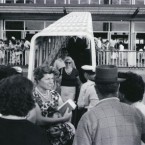 Every Story Counts! Recording Migration Heritage – A Wollongong Case Study |
In the mid-20th century, Wollongong was one of the fastest growing cities in Australia. The suitability of the local coal for steel production, the coastal location, and the availability of land, made Wollongong and Port Kembla ideal for industrial expansion. As a result there was a constant demand for labour, skilled and unskilled. Between 1947 and 1975 employment at the steelworks grew from 3,665 to 20,175. Migrants made this growth possible.
Every Story Counts! Recording Migration Heritage – A Wollongong Case Study is a new resource which will reflect local knowledge gathered at community workshops with former migrants. This publication will highlight important local heritage collections and records people’s memories of arriving in Australia and settling in Wollongong – such as Rina Montgomery’s story.
This richly illustrated book will be published in 2013. It will encourage people to record their migration history and experiences and to care for associated records, photos and family belongings. It will be a useful guide for other New South Wales community groups.
Every Story Counts! Recording Migration Heritage – A Wollongong Case Study is a NSW Migration Heritage Centre partnership with the Illawarra Migration Heritage Project Inc. The book was researched and written by heritage consultant and volunteer Meredith Walker and edited by John Petersen with the Illawarra Migration Heritage Project Inc.
PROJECT CONTACT:
Franca Facci, Chair, Illawarra Migration Heritage Project Inc.
Address:
PO Box 1589
South Coast Mail Centre
Wollongong NSW 2521
Tel: 02 4251 4710
Email: mhp@1earth.net
Wollongong Spaghetti
Rina Montgomery came to Australia from Italy in 1929 with her mother and brother to join her father who had settled in Wollongong three years earlier. Her parents ran a boarding house in Steeltown (Cringila) where many migrants found a home.
Their parents brought with them some kitchen equipment but, more often than not, everyday items were homemade as they could not be found in Australia.
 This pasta maker was brought to Australia in 1929 by Mistica Rosa Scapin (Rina Montgomery’s mother). |
“You had to have flour … and throw it onto the pasta, and then lower the pasta into the bowl. You cut the pasta to whatever length you wanted – 2ft 6″ long. Pasta was always made fresh. [You] could make it and dry it on a sheet, on a bed or table and store it.
Flour and eggs, salt in the water when cooking. Might do six eggs at a time. After breakfast mum did the dough and I turned the handle, while mum did cutting and flour from the bottom. … There are different shapes – most common one was spaghetti.”
Rina Montgomery
Photographs and text courtesy of the Illawarra Migration Heritage Project Inc. and Rina Montgomery


